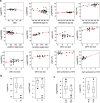Gene expression in breastmilk cells is associated with maternal and infant characteristics
- PMID: 26255679
- PMCID: PMC4542700
- DOI: 10.1038/srep12933
Gene expression in breastmilk cells is associated with maternal and infant characteristics
Abstract
Breastmilk is a rich source of cells with a heterogeneous composition comprising early-stage stem cells, progenitors and more differentiated cells. The gene expression profiles of these cells and their associations with characteristics of the breastfeeding mother and infant are poorly understood. This study investigated factors associated with the cellular dynamics of breastmilk and explored variations amongst women. Genes representing different breastmilk cell populations including mammary epithelial and myoepithelial cells, progenitors, and multi-lineage stem cells showed great variation in expression. Stem cell markers ESRRB and CK5, myoepithelial marker CK14, and lactocyte marker α-lactalbumin were amongst the genes most highly expressed across all samples tested. Genes exerting similar functions, such as either stem cell regulation or milk production, were found to be closely associated. Infant gestational age at delivery and changes in maternal bra cup size between pre-pregnancy and postpartum lactation were associated with expression of genes controlling stemness as well as milk synthesis. Additional correlations were found between genes and dyad characteristics, which may explain abnormalities related to low breastmilk supply or preterm birth. Our findings highlight the heterogeneity of breastmilk cell content and its changes associated with characteristics of the breastfeeding dyad that may reflect changing infant needs.
Figures



Similar articles
-
Single Cell RNA Sequencing of Human Milk-Derived Cells Reveals Sub-Populations of Mammary Epithelial Cells with Molecular Signatures of Progenitor and Mature States: a Novel, Non-invasive Framework for Investigating Human Lactation Physiology.J Mammary Gland Biol Neoplasia. 2020 Dec;25(4):367-387. doi: 10.1007/s10911-020-09466-z. Epub 2020 Nov 20. J Mammary Gland Biol Neoplasia. 2020. PMID: 33216249 Free PMC article.
-
Identification of nestin-positive putative mammary stem cells in human breastmilk.Cell Tissue Res. 2007 Jul;329(1):129-36. doi: 10.1007/s00441-007-0390-x. Epub 2007 Apr 18. Cell Tissue Res. 2007. PMID: 17440749 Clinical Trial.
-
Low vitamin B12 intake during pregnancy and lactation and low breastmilk vitamin 12 content in rural Kenyan women consuming predominantly maize diets.Food Nutr Bull. 2013 Jun;34(2):151-9. doi: 10.1177/156482651303400204. Food Nutr Bull. 2013. PMID: 23964388
-
Breastmilk cell trafficking induces microchimerism-mediated immune system maturation in the infant.Pediatr Allergy Immunol. 2018 Mar;29(2):133-143. doi: 10.1111/pai.12841. Epub 2018 Jan 8. Pediatr Allergy Immunol. 2018. PMID: 29197124 Review.
-
Potential of breastmilk in stem cell research.Cell Tissue Bank. 2019 Dec;20(4):467-488. doi: 10.1007/s10561-019-09791-6. Epub 2019 Oct 12. Cell Tissue Bank. 2019. PMID: 31606767 Review.
Cited by
-
Estrogen-related receptor β (ERRβ) - renaissance receptor or receptor renaissance?Nucl Recept Signal. 2016 Jun 21;14:e002. doi: 10.1621/nrs.14002. eCollection 2016. Nucl Recept Signal. 2016. PMID: 27507929 Free PMC article. Review.
-
Expression of Granulisyn, Perforin and Granzymes in Human Milk over Lactation and in the Case of Maternal Infection.Nutrients. 2018 Sep 4;10(9):1230. doi: 10.3390/nu10091230. Nutrients. 2018. PMID: 30181507 Free PMC article.
-
Profiling of mature-stage human breast milk cells identifies six unique lactocyte subpopulations.Sci Adv. 2022 Jul;8(26):eabm6865. doi: 10.1126/sciadv.abm6865. Epub 2022 Jun 29. Sci Adv. 2022. PMID: 35767604 Free PMC article.
-
Histology and Transcriptome Profiles of the Mammary Gland across Critical Windows of Development in Sprague Dawley Rats.J Mammary Gland Biol Neoplasia. 2018 Sep;23(3):149-163. doi: 10.1007/s10911-018-9401-7. Epub 2018 Jun 28. J Mammary Gland Biol Neoplasia. 2018. PMID: 29956080 Free PMC article.
-
Epigenetic Programming Through Breast Milk and Its Impact on Milk-Siblings Mating.Front Genet. 2020 Oct 2;11:569232. doi: 10.3389/fgene.2020.569232. eCollection 2020. Front Genet. 2020. PMID: 33133155 Free PMC article.
References
-
- Neville M. C. et al. Studies on human lactation. I. Within-feed and between-breast variation in selected components of human milk. The American journal of clinical nutrition 40, 635–646 (1984). - PubMed
Publication types
MeSH terms
Substances
Grants and funding
LinkOut - more resources
Full Text Sources
Other Literature Sources
Molecular Biology Databases
Research Materials

